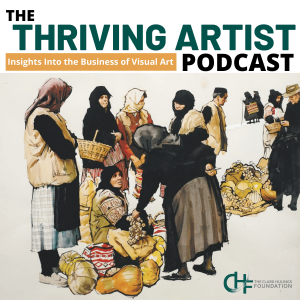
Willy Bo Richardson is a painter based in Santa Fe, New Mexico and an alumnus of CHF’s Art-Business Accelerator program. Visually, his work is abstract and colorful, with a repeating motif of stripes. Willy subtracts the trappings that condition our response to art—the frame, the pedestal— and weaves art into the setting itself. The Albuquerque Museum recently acquired one of his pieces for their permanent collection, and he’s currently working with Richard Levy Gallery— while pursuing corporate projects that include wall-art licensing, and mid-size installations in European health care and gerontology settings. Willy’s long-term goal is to create totally-immersive corporate environments.
CHF’s Program Results- “What I really got out of CHF was on two main levels. The first level is the nuts and bolts: how to be professional. So on one level, I can run my business the way any entrepreneur or individual business owner could do it. And then there’s another level, and that is working with the other fellows and learning side-by-side.”
- “One of the biggest lessons I got working with you and Elizabeth and the Fellows at Clark Hulings Fund was this similar path of fearlessness of being an entrepreneur and an artist. It’s the same fearlessness. And of course fearlessness actually starts with fear. It’s a project that seems scary and I’m going to do it anyway. And then it’s a little less scary. And then the next project, it’s a bigger project with same amount of fear but now I know I can get through it.”
- “The challenge was to make [the goal] so scary and big that you can never accomplish it, and I’m making small steps towards that.”
- “One of the things that I was so attracted to Clark Hulings for was that there’s all these disruptors happening. Even the idea of what an artist is, is shifting. And I think that creates opportunities for artists not only to start making a living, but also to inject themselves into the world.”
Art in Corporate Environments
- “Well, it started out a little bit as an idealist thing where I wanted to have my art to be available for the middle class.”
- “It’s an ambition of mine to put my work in front of people—not just those who have the opportunity with income and education to appreciate fine art.”
- “What my ‘big-dad ugly’ goal is, is to completely integrate [my work] into the environment, so that one does not think they are looking at art, but that they are sitting on a couch and the textiles, the pillows, the wall coverings, different architectural elements—we call it materials for the built-environment, and my paintings are integrated into that.”
Ecological Responsibility
- “I made a commitment to myself and others that I would only work with those that are working towards the safest practice as possible, which is sometimes more expensive, but that does not go against my primary goal, which is high quality. Safe for the environment and high-quality often can be hand-in-hand.”
- “I think that our culture is actually really receptive to the idea of putting something out into the world that is doing the least amount of harm on the environment as possible.”
Licensing in the Corporate Market
- “In the fine art world, it’s definitely kind of a no-no to license your work and to do reproductions, and that stems from a history where the technology was different.”
- “When I first started getting into reproductions while living in New York City, people were saying it was going to ruin my career. So every step of the way has been all the experts and those in the know telling me not to do things. That doesn’t mean when somebody says to not do something that it’s smart, it just means that you’ve got to figure out which things people are afraid of.”
- “Often times the art consultants are very open to whatever they think they can sell, and not so interested in one’s resume, which is really good for artists getting started—because it’s that Catch-22 of how do you get that first gallery. The first gallery wants to see that you have a resume, whereas the art consultants do not want to resume, they just want to see good work.”
- “After having a master’s degree and working towards being an artist, after enough years of working in the back of a gallery or having some other side job, I really wanted to see my main income come through multiple streams.”
Artists Working with Engineers
- “[Typically] the artist is last in line. So after the architects, the engineers, the city planners, then you have the art consultants which then connect with the interior designers and then from there the art is chosen. So really the artist is the last one in line, and I’m trying to get further up into the food chain.”
- “It’s not necessarily reinventing the wheel it’s more about admitting here we are in this place and time with incredible technology which can do all these things. Can we just get the architects and engineers to work with the artist? That’s kind of the idea. Can we get the artist more on the ground floor and start integrating?”
More Episodes
 2021-11-26
2021-11-26
 2020-10-14
2020-10-14
 2020-09-30
2020-09-30
 2019-07-12
2019-07-12
 2019-02-18
2019-02-18
 2019-01-23
2019-01-23
 2019-01-12
2019-01-12
Create your
podcast in
minutes
- Full-featured podcast site
- Unlimited storage and bandwidth
- Comprehensive podcast stats
- Distribute to Apple Podcasts, Spotify, and more
- Make money with your podcast
It is Free
- Privacy Policy
- Cookie Policy
- Terms of Use
- Consent Preferences
- Copyright © 2015-2024 Podbean.com





